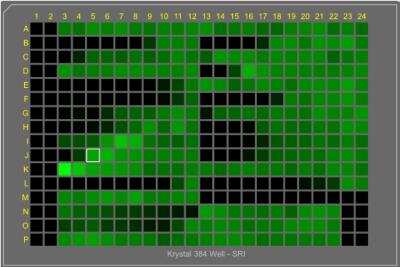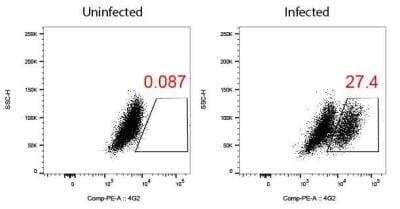Flavivirus group antigen Products
The Flavivirus group antigen antibody binds to the fusion loop at the distal end of domain II (EDII) of protein E. Flavivirus E is a glycoprotein that is the main antigen for membrane fusion between virus and host and entry into the cell, as well as inducing protective immunity by stimulating neutralizing antibodies (2, 4, 6). The E protein is 495 amino acids (aa) in length and has a theoretical molecular weight between 55 - 72 kDa, which varies based on glycosylation sites (2). Flavivirus E protein contains three domains (EDI, EDII, and EDIII) followed by a stem that contents to the helix-transmembrane domains (TMDs, TM1 and TM2) (2, 4, 6). The EDII contains an S-S bridge at its distal end and functions as a fusion loop (FL) for virus-mediated membrane fusion and antibody binding (2). Given the important role of Flavivirus protein E in host cell infection and membrane fusion, it has become a target for flavivirus disease prevention and treatment (2, 5).
Alternative names for Flavivirus group antigen include Envelope Protein and Protein E.
References
1. Ngono, A. E., & Shresta, S. (2018). Immune Response to Dengue and Zika. Annual review of immunology. https://doi.org/10.1146/annurev-immunol-042617-053142
2. Rey, F. A., Stiasny, K., Vaney, M. C., Dellarole, M., & Heinz, F. X. (2018). The bright and the dark side of human antibody responses to flaviviruses: lessons for vaccine design. EMBO reports. https://doi.org/10.15252/embr.201745302
3. Zhang, X., Jia, R., Shen, H., Wang, M., Yin, Z., & Cheng, A. (2017). Structures and Functions of the Envelope Glycoprotein in Flavivirus Infections. Viruses. https://doi.org/10.3390/v9110338
4. Laureti, M., Narayanan, D., Rodriguez-Andres, J., Fazakerley, J. K., & Kedzierski, L. (2018). Flavivirus Receptors: Diversity, Identity, and Cell Entry. Frontiers in immunology. https://doi.org/10.3389/fimmu.2018.02180
5. Boldescu, V., Behnam, M., Vasilakis, N., & Klein, C. D. (2017). Broad-spectrum agents for flaviviral infections: dengue, Zika and beyond. Nature reviews. Drug discovery. https://doi.org/10.1038/nrd.2017.33
6. Crill, W. D., & Chang, G. J. (2004). Localization and characterization of flavivirus envelope glycoprotein cross-reactive epitopes. Journal of virology, 78(24), 13975-13986. https://doi.org/10.1128/JVI.78.24.13975-13986.2004
20 results for "Flavivirus group antigen" in Products
20 results for "Flavivirus group antigen" in Products
Flavivirus group antigen Products
The Flavivirus group antigen antibody binds to the fusion loop at the distal end of domain II (EDII) of protein E. Flavivirus E is a glycoprotein that is the main antigen for membrane fusion between virus and host and entry into the cell, as well as inducing protective immunity by stimulating neutralizing antibodies (2, 4, 6). The E protein is 495 amino acids (aa) in length and has a theoretical molecular weight between 55 - 72 kDa, which varies based on glycosylation sites (2). Flavivirus E protein contains three domains (EDI, EDII, and EDIII) followed by a stem that contents to the helix-transmembrane domains (TMDs, TM1 and TM2) (2, 4, 6). The EDII contains an S-S bridge at its distal end and functions as a fusion loop (FL) for virus-mediated membrane fusion and antibody binding (2). Given the important role of Flavivirus protein E in host cell infection and membrane fusion, it has become a target for flavivirus disease prevention and treatment (2, 5).
Alternative names for Flavivirus group antigen include Envelope Protein and Protein E.
References
1. Ngono, A. E., & Shresta, S. (2018). Immune Response to Dengue and Zika. Annual review of immunology. https://doi.org/10.1146/annurev-immunol-042617-053142
2. Rey, F. A., Stiasny, K., Vaney, M. C., Dellarole, M., & Heinz, F. X. (2018). The bright and the dark side of human antibody responses to flaviviruses: lessons for vaccine design. EMBO reports. https://doi.org/10.15252/embr.201745302
3. Zhang, X., Jia, R., Shen, H., Wang, M., Yin, Z., & Cheng, A. (2017). Structures and Functions of the Envelope Glycoprotein in Flavivirus Infections. Viruses. https://doi.org/10.3390/v9110338
4. Laureti, M., Narayanan, D., Rodriguez-Andres, J., Fazakerley, J. K., & Kedzierski, L. (2018). Flavivirus Receptors: Diversity, Identity, and Cell Entry. Frontiers in immunology. https://doi.org/10.3389/fimmu.2018.02180
5. Boldescu, V., Behnam, M., Vasilakis, N., & Klein, C. D. (2017). Broad-spectrum agents for flaviviral infections: dengue, Zika and beyond. Nature reviews. Drug discovery. https://doi.org/10.1038/nrd.2017.33
6. Crill, W. D., & Chang, G. J. (2004). Localization and characterization of flavivirus envelope glycoprotein cross-reactive epitopes. Journal of virology, 78(24), 13975-13986. https://doi.org/10.1128/JVI.78.24.13975-13986.2004
Recombinant Monoclonal Antibody
| Reactivity: | Human, Virus, Primate - Macaca mulatta (Rhesus Macaque), Virus - HPV |
| Details: | Mouse IgG2a Kappa Monoclonal Clone #D1-4G2-4-15 (4G2) |
| Applications: | IHC, WB, ELISA, ICC/IF, Flow, +2 More |
Recombinant Monoclonal Antibody.
| Reactivity: | Human, Virus |
| Details: | Rabbit IgG Kappa Monoclonal Clone #D1-4G2-4-15 (4G2) |
| Applications: | IHC, WB, ELISA, ICC/IF, Flow, +2 More |
Recombinant Monoclonal Antibody
| Reactivity: | Virus |
| Details: | Mouse IgG2a Kappa Monoclonal Clone #D1-4G2-4-15 (4G2) |
| Applications: | IHC, WB, ELISA, ICC/IF, Flow, +2 More |
Recombinant Monoclonal Antibody
| Reactivity: | Virus |
| Details: | Mouse IgG2a Kappa Monoclonal Clone #D1-4G2-4-15 (4G2) |
| Applications: | IHC, WB, ELISA, ICC/IF, Flow, +2 More |
Recombinant Monoclonal Antibody
| Reactivity: | Virus |
| Details: | Mouse IgG2a Kappa Monoclonal Clone #D1-4G2-4-15 (4G2) |
| Applications: | IHC, WB, ELISA, ICC/IF, Flow, +2 More |
Recombinant Monoclonal Antibody
| Reactivity: | Virus |
| Details: | Mouse IgG2a Kappa Monoclonal Clone #D1-4G2-4-15 (4G2) |
| Applications: | IHC, WB, ELISA, ICC/IF, Flow, +2 More |
Recombinant Monoclonal Antibody.
| Reactivity: | Virus |
| Details: | Rabbit IgG Kappa Monoclonal Clone #D1-4G2-4-15 (4G2) |
| Applications: | IHC, WB, ELISA, ICC/IF, Flow, +2 More |
Recombinant Monoclonal Antibody.
| Reactivity: | Virus |
| Details: | Rabbit IgG Kappa Monoclonal Clone #D1-4G2-4-15 (4G2) |
| Applications: | IHC, WB, ELISA, ICC/IF, Flow, +2 More |
Recombinant Monoclonal Antibody
| Reactivity: | Virus |
| Details: | Mouse IgG2a Kappa Monoclonal Clone #D1-4G2-4-15 (4G2) |
| Applications: | IHC, WB, ELISA, ICC/IF, Flow, +2 More |
Recombinant Monoclonal Antibody
| Reactivity: | Virus |
| Details: | Mouse IgG2a Kappa Monoclonal Clone #D1-4G2-4-15 (4G2) |
| Applications: | IHC, WB, ELISA, ICC/IF, Flow, +2 More |
Recombinant Monoclonal Antibody
| Reactivity: | Virus |
| Details: | Mouse IgG2a Kappa Monoclonal Clone #D1-4G2-4-15 (4G2) |
| Applications: | IHC, WB, ELISA, ICC/IF, Flow, +2 More |
Recombinant Monoclonal Antibody.
| Reactivity: | Virus |
| Details: | Rabbit IgG Kappa Monoclonal Clone #D1-4G2-4-15 (4G2) |
| Applications: | IHC, WB, ELISA, ICC/IF, Flow, +2 More |
Recombinant Monoclonal Antibody.
| Reactivity: | Virus |
| Details: | Rabbit IgG Kappa Monoclonal Clone #D1-4G2-4-15 (4G2) |
| Applications: | IHC, WB, ELISA, ICC/IF, Flow, +2 More |
Recombinant Monoclonal Antibody.
| Reactivity: | Virus |
| Details: | Rabbit IgG Kappa Monoclonal Clone #D1-4G2-4-15 (4G2) |
| Applications: | IHC, WB, ELISA, ICC/IF, Flow, +2 More |
Recombinant Monoclonal Antibody
| Reactivity: | Virus |
| Details: | Mouse IgG2a Kappa Monoclonal Clone #D1-4G2-4-15 (4G2) |
| Applications: | IHC, WB, ELISA, ICC/IF, Flow, +2 More |
Recombinant Monoclonal Antibody
| Reactivity: | Virus |
| Details: | Mouse IgG2a Kappa Monoclonal Clone #D1-4G2-4-15 (4G2) |
| Applications: | IHC, WB, ELISA, ICC/IF, Flow, +2 More |
Recombinant Monoclonal Antibody.
| Reactivity: | Virus |
| Details: | Rabbit IgG Kappa Monoclonal Clone #D1-4G2-4-15 (4G2) |
| Applications: | IHC, WB, ELISA, ICC/IF, Flow, +2 More |
Recombinant Monoclonal Antibody.
| Reactivity: | Virus |
| Details: | Rabbit IgG Kappa Monoclonal Clone #D1-4G2-4-15 (4G2) |
| Applications: | IHC, WB, ELISA, ICC/IF, Flow, +2 More |
Recombinant Monoclonal Antibody.
| Reactivity: | Virus |
| Details: | Rabbit IgG Kappa Monoclonal Clone #D1-4G2-4-15 (4G2) |
| Applications: | Flow |
Recombinant Monoclonal Antibody
| Reactivity: | Virus |
| Details: | Mouse IgG2a Kappa Monoclonal Clone #D1-4G2-4-15 (4G2) |
| Applications: | IHC, WB, ELISA, ICC/IF, Flow, +2 More |


![Flow Cytometry: Flavivirus group antigen Antibody (D1-4G2-4-15 (4G2)) - Chimeric - Azide and BSA Free [NBP2-52666] Flow Cytometry: Flavivirus group antigen Antibody (D1-4G2-4-15 (4G2)) - Chimeric - Azide and BSA Free [NBP2-52666]](https://resources.bio-techne.com/images/products/Flavivirus-group-antigen-Antibody-D1-4G2-4-15-4G2-Chimeric-Flow-Cytometry-NBP2-52666-img0005.jpg)




![Flavivirus group antigen Antibody (D1-4G2-4-15 (4G2)) [mFluor Violet 450 SE] [NBP2-52666MFV450] -](https://resources.bio-techne.com/images/products/nbp2-52666mfv450_rb-flavivirus-group-ant-mab-d1-4g2-4-15-4g2-mfv450-se-226202313291039.png)
